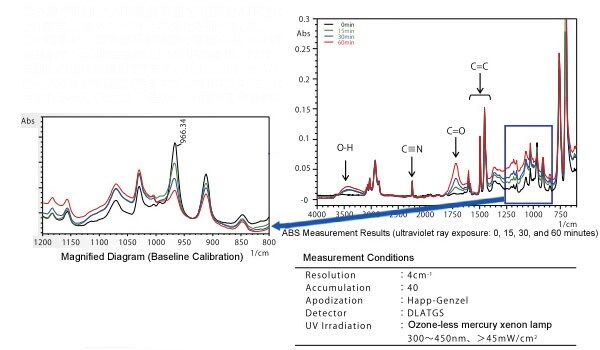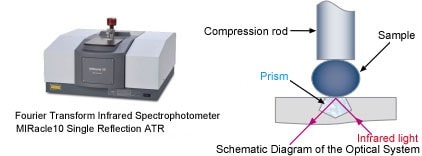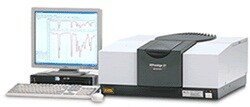CFRP Quality Control - Evaluation of the Degradation of a Resin Surface via FTIR -
Evaluation of the Degradation of a Resin Surface via FTIR
In addition to of heating, organic solvents, and acidic or alkaline solutions, resins may be denatured or degraded by ultraviolet rays. Durability against ultraviolet rays is particularly necessary for resin products that are used outdoors. Accordingly, in this test, acrylonitrile-butadiene-styrene (ABS) resins were exposed to ultraviolet rays and then analyzed by FTIR.
The surface of the ABS resin exposed to ultraviolet rays was measured with the single reflection ATR method, and changes in the infrared spectrum were investigated. The results show that O-H and C=O stretching vibrations caused an increase in absorption, i.e. progression of oxidation, with increasing ultraviolet exposure time. Furthermore, a reduction in the 966 cm-1 peak can be seen, indicating absorption due to =C-H out-of-plane deformation vibrations of the transvinylene group contained in the butadiene. Striking changes are not evident in peaks due to the stretching vibrations of the nitrile group -C≡N or the styrene C=C bonding. These results indicate that oxidation of ABS resins progresses from their butadiene parts due to the impact of ultraviolet rays.

FTIR Single Reflection ATR Method
In the single reflection ATR method, the sample is put in close contact with the surface of a prism with a diameter of approximately 2 mm, and the infrared spectrum is then measured. In addition to flat samples, this method can be applied to samples with curved surfaces and powdered samples. A liquid sample can also be measured by simply placing a drop of it on the prism.
The following shows a photograph of the external appearance of the IRAffinity-1 Fourier Transform Infrared Spectrophotometer equipped with the MIRacle10 Single Reflection ATR Attachment, as well as a schematic diagram of the optical system. When the infrared light shining from the prism is reflected at the interface between the prism and the sample, information is obtained about the sample surface (to a depth of approximately 1 µm). Accordingly, not only is sample dilution and other pre-treatments unnecessary, but information regarding the sample surface is easily obtained.

Infrared Spectrophotometers

The ATR method measures samples by pressing them tightly against the surface of a plate-shaped prism made of material with a high refractive index. The surface roughness of paper may vary somewhat depending on the type of paper, but surface spectra can be measured for most papers by pressing them harder and more tightly against the prism.


